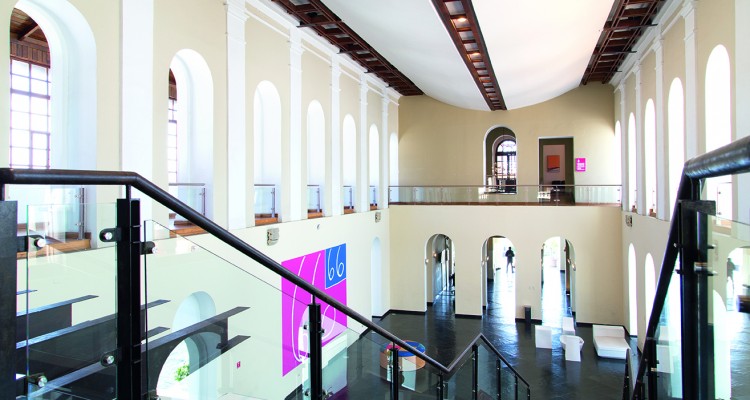LA COMPAÑÍA DE JESÚS CHURCH
By: Belén Guerrero
The photos of La Compañía church undoubtedly stand out in these pages. Nevertheless, it´s important to describe it in order to be able admire one of the key spots in Quito´s colonial heritage. Certainly it deserves a special visit.
La Compañía church is different from the rest of Quito´s colonial era churches for several reasons. Among them, the central portion of the main altar does not hold a sculpture of Christ on the Cross, as do most Catholic churches, but rather a painting of the Virgen de los Dolores or Virgen de la Dolorosa (Madonna of the Pain).
This harks back to 1906 when San Gabriel school, then located adjacent to the church, became the scene of a miracle. A group of thirty five students, back from a hike up the Pichincha volcano, entered the dining room and saw the image of the Madonna blinking continually over a span of fifteen minutes. This event, still a vivid memory among the citizens of Quito, was later validated by the Vatican as an authentic miracle.
The painting exhibited at La Compañía is not the original. That one is kept in the chapel of San Gabriel school in the northern part of Quito. However, the church now includes the dining room where the miracle took place. It was converted into the Capilla del Milagro (Chapel of the Miracle), completely carved in wood. It can be accessed via Benalcázar Street.
The lower part of the main altar holds a bronze urn that was donated by former President Gabriel García Moreno. This urn contains the most important heirlooms of Saint Marianita de Jesús, Quito´s patron saint. She´s allegedly the author of a famous statement, “Ecuador will not collapse due to earthquakes but due to bad governments”. Saint Marianita is considered as a national hero because, according to legend, upon her death in 1645 at the tender age of twenty six, the earthquakes and plagues that had struck Quito suddenly ceased.
One step inside the church and your eyes will begin to wander every which way, almost unable to choose whether to focus first on the ceiling or the columns or the paintings or the altars. Construction began in 1605 and ended in 1765. Once the church is observed in detail, you come to understand why its construction took 160 years.
Every single area is decorated and finely finished. The Baroque style is predominant throughout the church. A “fear of emptiness” can be felt as you walk around because every single square inch of surfaces exhibits colors or carvings.
La Compañía was built with local construction materials. The walls and columns used volcanic rocks from the slopes of the Pichincha volcano next door to Quito. Pumice stone and bricks were chosen for the ceiling and domes because they are lightweight. Something that strikes all visitors is the golden covering on most surfaces, known as gold laminate or gold leaf. The experts estimate some 114 pounds of 24 karat gold were spread throughout the church.
There are as many stories about this church as there are details in its decor, so it´s impossible to cover all of them in a few pages. The pulpit was considered the living heart of the church because, back then, priests said mass from the pulpit. It´s shaped as a cup or chalice so that its own structure can function as a voice amplifier. Two hundred fifty eight paintings of human faces decorate the pulpit from its base to its top, some of them as small as a thumbnail.
The rear door, also known as a partition, serves to improve acoustics, not allowing sounds to escape. On its left side is a staircase that leads upstairs to the choir rows. On its right side is another identical staircase. Except the latter is just a painting, a trompe-l´oeil, an optical illusion to make visitors believe both staircases are real. This was a common technique in Baroque churches in order to preserve symmetry. The organ was manufactured in the United States and assembled in Quito in 1889. It´s played during Sunday masses at 10:30 a.m. and also in sacred music concerts during Easter week.
Two well know paintings absolutely must be mentioned. First, El Infierno (Hell), with Lucifer as the protagonist, depicts twenty five sins and their respective punishments. Across from this painting is El Juicio Final (Last Judgement), showing how the eternal fate of each person is decided without taking into account who that person was. These two paintings were deliberately placed by La Compañía´s Jesuit priests so that people entering the church would feel threatened by the image of Hell and those leaving, following mass, would keep in their minds the future holy judgement on their behavior.
Touring La Compañía requires plenty of time to savor its Baroque splendor without feeling rushed. A guide is strongly recommended, not only to learn the religious and the artistic details of the church but also to hear its many ancient stories and legends.
INFORMATION
MASS
Monday to Sunday – morning and afternoon
VISITS
Monday to Friday: 09:30 a.m. to 5:30 p.m.
Saturday: 09:30 a.m. to 4:30 p.m.
Sunday: 1h30 p.m. to 4:30 p.m.
TELEPHONE: 258 4175
ADDRESS: García Moreno and Sucre Streets
ENTRANCE
Foreign adult: $4 dollars
Foreign student: $2
National adult: $2
National student: $1
Seniors, children and handicapped: free

